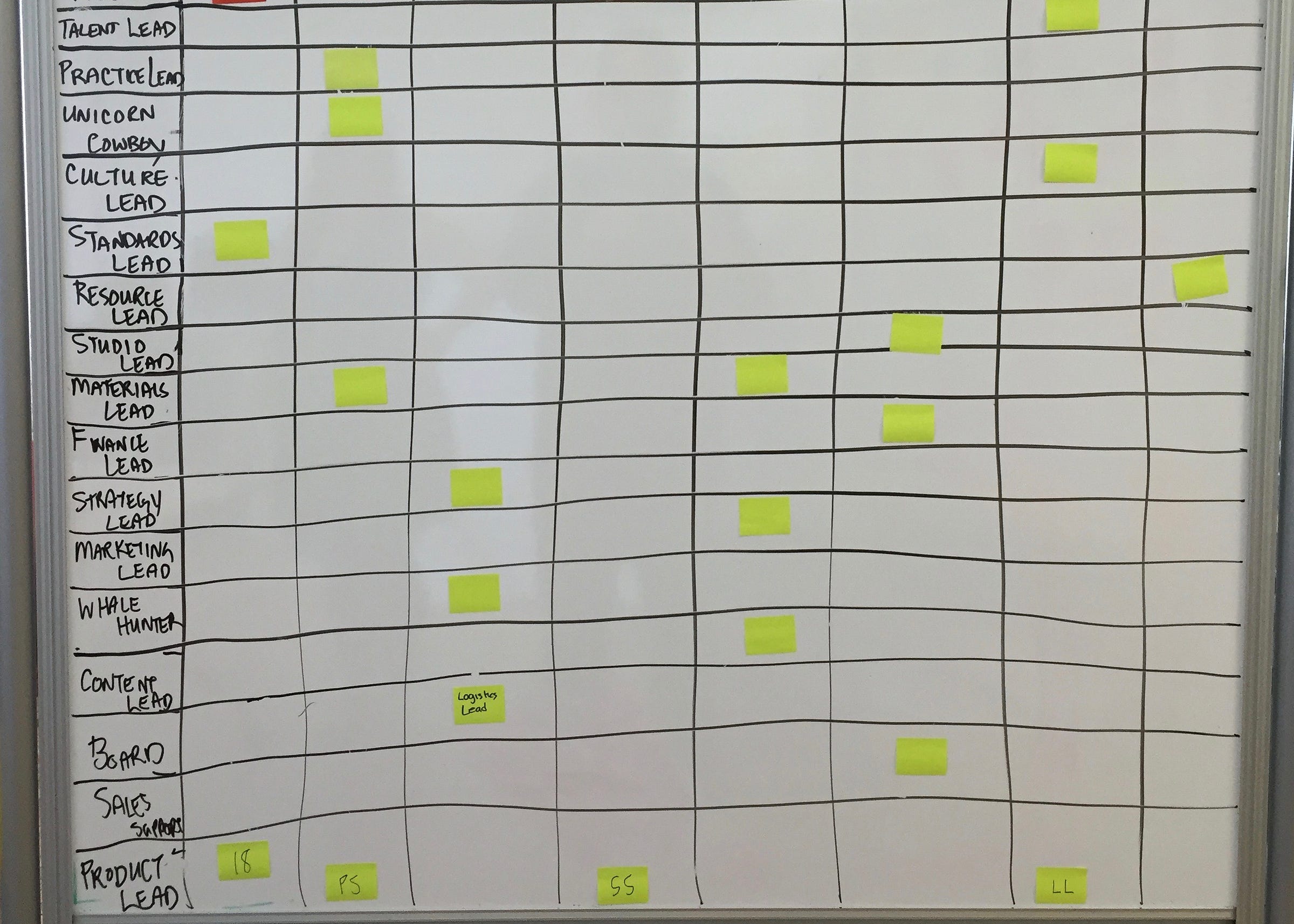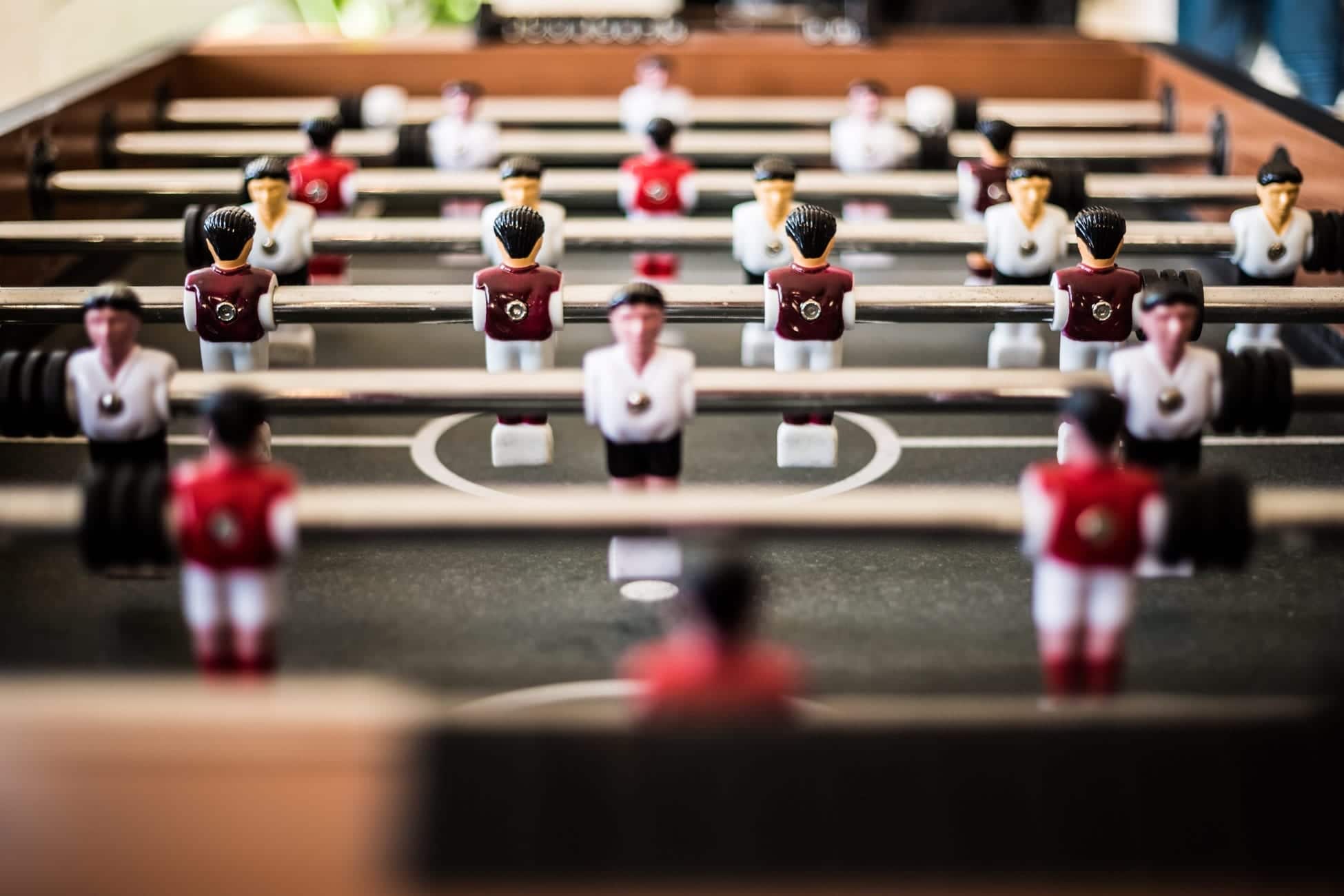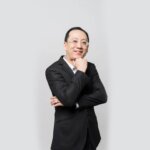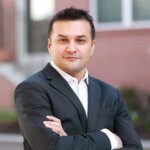At The Moment, we close our innovation studio to all client and regular internal work during three separate week-long strategic planning and organizational development “retreats” every year.
When we tell people about this practice, they are amazed, impressed and often question how and why we make this kind of investment.
We have a long history designing and facilitating strategic planning offsites for our clients. Often these would be annual or even less frequent. The strategic planning horizon might be 3–5 years, with 1 year business plans as the primary output. It used to be a big part of our work. We know what works, what doesn’t, and we know what’s possible in one, two or three days facilitating groups of leaders through activities that are designed to move their attention from the day-to-day up and out to the horizons of the future.
We also know that strategic plans are useless without action, and that many a change agenda has crashed and burned shortly after being created when plans meet the realities of teams who may not be ready, or leaders who aren’t able to take up the work, or when assumptions are proven wrong by the unfolding of events.
So we have come to understand that a strategic planning retreat can be powerful, but is not sufficient. That doesn’t mean that they aren’t valuable investments in the increasingly busy world of work; on the contrary, they are so valuable that we need more of that kind of intentionally reflective and co-creative time together as the world around us changes at an accelerating pace.
Knowing all this, when our team takes time out from our busy schedules to do this work on ourselves, we know that the five days we dedicate are precious and that they provide a unique opportunity: to take ourselves through a deep process adapted from Otto Scharmer’s Theory U.

This (long) post is intended to illustrate that process by sharing how we used it during our most recent Strategy Week (“Strat Week”).
Why 3 Times a Year?
Our work as an innovation consulting and design firm historically follows a regular rhythm and business cycle. We have known this for a while, but it wasn’t until we read about how our friends at August Public Inc (formerly of Undercurrent) organized their calendar that we really saw the opportunity.
Our business cycle begins in January, with a number of new projects starting up in the new year. Many of those projects close or shift into a new phase around May, which launches another wave of busy project work before the doldrums of summer vacations. Then in late August our clients are getting ready to launch new initiatives in the fall.
We schedule our Strat Weeks for these periods: the first week in January, the first week in May and the last week of August — long in advance. We let our clients know that this time is sacred to us, and we plan our project work around them. We also organize our business planning around these trimesters, rather than conventional and arbitrary fiscal quarters.
Our strategic planning weeks sit at these three natural pivot points in our business cycle, where we have completed a lot of work we can learn from and share, and at a key moment when new work is being set up for the next period.
Why Five Days?
As a small services firm working in the rapidly changing field of innovation design, with clients who themselves are going through rapid change, disruption and transformation, our team has a lot to process. We need to be constantly adapting and reinventing ourselves to meet these rapidly changing conditions.
We also accumulate enormous amounts of learning through our work. Given this amount of learning, the space required to share, internalize, integrate and mobilize all the new knowledge takes time.
Part of our expertise lies in designing and facilitating collaborative processes for groups. We know that it takes time for people to work with not just the business and learning content, but also to connect to their own emotional selves in a way that supports the dynamics of the team as a whole. If you try to rush these processes to get the work done without attending to the human needs of those involved, we know that there is risk of wasting all that time and effort by leaving people behind.
This is often where plans fail to transform into committed action. If you can’t give enough space to the human dynamics at play, then you probably shouldn’t even bother trying to effect change. Trust, commitment and shared clarity are essential to the kind of strategic action that will need to follow through on any plan.
Who is Involved?
In our case, answering this question is easy: Everyone is involved. We are an 8-person team, and so strategy has always been a full team practice. With our growth plans, this will no doubt shift, but we know from our process design and facilitation work that this kind of group collaboration work can scale to much larger groups. Groups of 20, 60, 120 — and even larger — can engage in this kind of process, but there is a unique power that exists in the small group format.
As we grow, we will adapt the design of our Strat Weeks so that we can alternate between small group and large group activities, but I can’t imagine it not being a time for everyone in the organization to engage in this kind of reflection, reinvention and strategic thinking. It’s in our DNA.
Preparation
Erika and I led the initial design of the week, and then we invited other members of the team to contribute to and lead different modules. Part of our preparation came in the form of background research and the preparation of presentation material. But other team preparation came from an unusual source: Gimlet Media’s amazing podcast series, “Startup”.
We made listening to Startup required pre-work for the whole team. We recognized ourselves in many of the amazing moments, challenges and triumphs that the Gimlet team documented of themselves starting their own business. We were inspired by the transparency and power of storytelling to make sense of the uncharted territory of creating something that has never been done before. (Alex Blumberg and Matt Lieber, if you ever want help facilitating your own internal planning week, let’s talk!)
Day One: Evaluation and Problem Definition
Learning, Reflection and Evaluation
Our May 2016 Strat Week came at an important inflection point in our business. We had pivoted our value proposition 8 months prior, and now we had a great opportunity to evaluate our work and share our lessons learned. We focused our learnings on how our practice is evolving, how the business side of our work is doing, and how our clients are being impacted by that work. The morning of Day One was all about sharing these learnings from key projects, with team members presenting to the rest of the team.
A New Financial/Operating Model
We also needed to pay particular attention to our financial and operating model, with full transparency to all. Transparency is essential for the full team to have all the context to guide their decisions. So the Operations team prepared a simplified spreadsheet-based model of our business that would make sense to everyone.
This model was designed around our customer journey and business lifecycle, showing how marketing and business development leads to delivery to clients and how delivery to clients is supported by many of our internal operational activities and infrastructure. Think of the model as a Service Design approach to understanding our business financials.
This approach was much more useful than sharing accounting reports that seem to obscure rather than clarify things for those who didn’t know GAAP accounting principles or have lots of experience reading financial statements.
Problem Definition
This model was used to generate a number of different scenarios of our present and future. By working with scenarios in the context of what we had learned in the morning about our most recent project work, the problem we were there to solve became a clear and burning platform for change:
How might we create the conditions and set priorities for sustainable growth in pursuit of our purpose?
The scenarios we developed became reference points and common language for the rest of the week. For example:
How might we let go of X and start doing Y in order to move from Scenario 1 to Scenario 3?
All of our subsequent conversations were anchored in this shared understanding of how the business works now, or could work in the future, as well as a clarified set of problem definitions.
We left Day One feeling emotionally uncertain, and pretty raw. The size and scope of our challenge and opportunity was being felt by all, and many of us went home concerned about the implications: Were we up to the challenge of rapid growth? Would we all be ok through the change?

Day Two: Deconstructing and Deep Reflection
Deep Dialogue in a Fishbowl
Rather than get to work right away solving problems, creating strategies or addressing specific opportunities, Day Two was spent working on us. Who are we, as humans, as a team, in the work we feel called to do? Our original plan for this day was to tackle more concrete work, but after Day One we knew that we needed to change our plan and spend more time processing and making sense of what we had learned about ourselves the day before.
The morning of Day Two was perhaps the most powerful moment of the week – at least it was for me. We needed to hold space for each other to connect into how we were feeling and making sense of the previous day. We did this using a modified version of a liberating structure we often use with clients, called Fishbowl.
We have a simple rule: we invite the whole person in to work. That means that when we feel insecurities, or pressures at home, or fears about the future, we invite that in and work with it not as off-topic material or a distraction, but as material that is essential for our work. We know that if we don’t work with the whole person in this way, the work we need to do with our clients and on ourselves won’t be done as well.
In this case, we decided that Daniel, Greg and I as the co-founders and owners of the business needed to hold the space for our team in order to hear all their voices. So we sat in the outer circle of the fishbowl, following the rule of Fishbowl to not react or speak to what we were hearing, while our team had a conversation in the inner circle.
It was an incredible moment for us as leaders. By sharing our business challenge with our team with full transparency, we had already created a shift. And now we got to hear how they thought about the challenge from a variety of very personal perspectives. We heard and felt how committed they were, their hopes as well as their fears.
Then we switched, and our team held space for us as co-founders and team members to be in the inner circle so we could share our own hopes, dreams, fears and uncertainties. There were tears. Building a business, especially a purpose-driven business like ours, is a very personal, intimate experience and we don’t shy away from the emotional side of it.
The final step was to collapse the fishbowl and return to one team sitting in a circle, having one conversation from a new place of authenticity and openness.
In this case, our dialogue process took the entire morning of Day Two. Is that a lot? Maybe. We’re heartful, open people who enjoy talking and we are unafraid of surfacing and unpacking tensions in order to resolve them. We know that when we create the space for this kind of dialogue and give it our full attention, the thing that happens is always the right thing.
Power, Authority and Decision-making
Rather than get right down to more strategy or planning work in the afternoon, Erika presented a piece on power, authority and decision-making. This was always part of our plan, as we knew we had some challenges in this area. We co-founders were holding onto too much even after having grown a more complete team, and many of our practices for decision-making were not explicit or clear to all. So we spent some time exploring different models, and opted to use a combination of the advice and consent decision-making modelsfor the vast majority of the things we do.
This was an important step in our journey to being more of a Teal organization as we grow. If you’re not familiar with this concept, read Reinventing Organizations author Frederic Laloux’ summary article for more background on the history, principles and methods. (Erika will be writing a separate piece that will go further into our journey into Teal.)
For the purposes of this post, it is enough to say that we are looking to become more adaptive, more responsive, more self-managing and more purpose-driven in all aspects of our organization’s structures and processes. Decision-making practices was the most important place for us to start.
Deconstructing and Unlearning
In retrospect, I believe that this deep reflection work on Day Two was key to our being receptive to new thinking. We had unconsciously over the first two days been moving down the U, downloading, unlearning, deconstructing and letting go of our old ideas in order to be able to sense from a new and more open place.
Day Three: Sensing and Strategy
Sensing into Our Environment
Turning our attention to some of the more traditional work of strategy began with a classic SWOT analysis, as well as an evaluation of the current state product-market fit of our three core offerings using the Value Proposition Canvas. We integrated our learnings from Day One while drawing upon previous work continually scanning our competitive and market environments, and the larger environmental trends and drivers we operate within.
We believe strongly that this kind of scanning of the environment is an ongoing and continuous activity: gathering signals, looking for trends. We spend much of our time working on these kinds of activities with our clients, so our team’s sense-making skills are highly developed, which is a great asset for this kind of work.
Sensing into Our Purpose
Before beginning to climb our way back up the U, the most important and powerful part of the process needed to be attended to. Otto Scharmer refers to this stage as “presencing”, and it is always a difficult thing to describe because it is not really observable.
Instead, it takes place from a mysterious source within each of us. The work of unlearning, deconstructing and letting go left each of us individually (and the team collectively) in an extremely uncertain, ambiguous but open state of receptivity to signals, having successfully suppressed our habits of reacting or defending our everyday beliefs and self-images.
I believe that presencing was happening in the shared space we created for ourselves, as well as in our dreams at night. We know from working with many teams on multi-day collaborative sessions that “sleeping on it” is a real method not to be underestimated. Our brains kept working on the challenge even while we slept. This was exhausting, but you could literally feel it happening.
Regardless of where it comes from, all this hard work of preparation put the team into the right state to allow us to sense into our purpose with far more clarity.
For us, our purpose is the “Why” of what we do. It is our central organizing principle. In a Teal organization, purpose trumps profit. That doesn’t mean that we don’t pursue profits, but it does mean that when push comes to shove, we will not allow short-term profit considerations to damage our purpose.
Purpose and Value Proposition
At Greg’s suggestion, we used the following framework to develop a Theory of Change in order to refine our purpose:
- If we do this… (activities)
- for these people… (stakeholders/customers)
- which enables them to… (outcomes)
- then we will… (impacts)
- which serves our purpose to… (aspirational goal)
We drew sketches of our theory of change and how we understood how our programs created real impact, and how that expressed itself in our value propositions.
The result of all this was later combined into a new unifying purpose-driven value proposition:
The Moment’s purpose is to contribute to the development of sustainable, thriving and prosperous organizations, communities and economies. [purpose]
We accomplish our purpose by working with leaders and teams in organizations facing disruptive change. [customers]
We help these leaders and teams to build the strategies, projects, capabilities, knowledge and culture that will enable them to continuously create new value in fast-changing times by positively impacting the lives of people. [outcomes and impact]
Our long-term innovation programs accomplish this goal by providing leaders and teams with the capacity, knowledge, expertise and ongoing development they need to become sustainably innovative. [activities]
To be clear, these words were not the output of Day Three. Rather, they were synthesized from our raw material after having more time to reflect. At the time things felt much more ambiguous and unfinished. But we knew that the seeds were on our boards in the studio. And we are used to sitting with the resulting ambiguity longer than most teams normally can bear.
Day Four: Restructuring into Role Clarity
Jobs-to-be-Done
Erika told a story explaining how she learned that caterpillars transformed into butterflies through metamorphosis. As she described it, rather than shrinking legs and sprouting wings, the caterpillar dissolved into a kind of primordial goo which was then reshaped into a new form.
The previous days of hard work had really been about transforming ourselves into goo. Jobs-to-be-Done were the structural DNA of our new form. We used this framework to generate all the jobs that needed doing in our organization: in client projects, in day-to-day functions, in leadership…everything.
The jobs-to-be-done framework is:
When (some situation occurs), I need to (do a job), so that (outcome).
We hadn’t done this so comprehensively before, so it took some time, working in pairs to generate, review, cluster and theme the hundreds of jobs we discovered we were doing (and many we weren’t). But this was essential for the next step of our work: creating new roles.
Day Five: Roles, Project Teams and Plans
New Value Proposition: 12–18 Month Innovation Programs
On Day Five, it was time to divide and conquer to get our primary deliverables done. We needed a new business plan, centred on our renewed purpose and a new unifying value proposition.
We had realized that the way we could make our greatest impact on the world was to help our clients integrate a human-centred and adaptive approach to innovation into their organizations and teams; that work takes time, clarity of purpose, the right relationship with leaders and our commitment to being there through the whole journey until the new practices are “just how we do things around here”.
We developed our 12–18 month innovation program product concept to a draft that we believe reflects all our learnings and experiences in a way that our customers are going to love. The test will be in the coming weeks, as we bring this new value proposition to a select group of clients and prospects to see how well this more impactful offering will match their needs.

Organization Design: Role Descriptions and Casting
While that work was underway, another team was refining our role definitions from the jobs-to-be-done, and making some initial attempts at casting those roles from among the team.
In this Teal approach, a role is not a job title. Each individual holds multiple roles. Within our client project work, roles are cast at project inception and different team members will play different roles depending on the mix of capabilities and the needs of the project. For our internal functions (finance, staffing, marketing, etc) we cast roles for the coming trimester, knowing that we would probably revisit them again at our next Strat Week, ready to make changes and rotate roles where it makes sense.
We also needed to cast these roles with our decision-making process in mind. For example, as Marketing Lead, Simon is the one who will be making decisions after following the advice process. Where another role, like Carolynn in Finance, feels they cannot consent to a decision (spending a lot more money than budgeted, for example), then a conflict resolution process would be triggered to address the objection or resolve the tension.
The real work remains as we enact and embody these new principles and processes into a new way of working and making decisions. This end to our Strat Week really was a prototype of this new structure, trying on the new roles and processes for size while we were in the safe space we had created for ourselves.

Impact
A bit more than a week later, we know the investment of five days and lots of effort to go deep is already paying off. This has happened before. After last summer’s Strat Week, we saw almost immediate impact.
We started talking differently, and people started responding differently. When we talk about who we are, what we do and why, we are now much clearer and bolder. That clarity and boldness is compelling to people, and they respond very positively, which immediately reinforces the new behaviours, turning plans into action right away.
Our newly enabled team is stepping into their new roles with great aplomb and confidence. Watching this is affirming to us as co-founders, and it reinforces the trust we have placed in this team to do the right thing in pursuit of our purpose, knowing that we have their backs and they have ours.
I can feel that a shift has already happened. I already know that this five days was a remarkable achievement, and will be seen as a major milestone in the future history we are writing for ourselves.
For me personally, feeling liberated from much that I had been holding onto is allowing me to step into my leadership in a whole new way. It is also allowing me to refocus on my own well-being as a person, knowing that my team needs me to not be a burned-out control freak. And I know that my team will have my back and help me achieve my purpose, just as each member of the team will be supported in theirs.
It is a remarkable feeling. It’s worth every penny of that five days investment. And the return on that investment is going to be very significant, if the early signals are any indication.
References and Inspirations
We couldn’t have done the work we did without the contributions of several important supporters, inspirations and allies. Our tribe of people who are reshaping the future of work are incredibly smart people you should pay attention to:
Must read: Reinventing Organizations, Frederic Laloux – for the inspiration
The Reinventing Organizations Wiki — great resources for becoming Teal
The Responsive.org Community for the manifesto and connections
Mark Raheja, August Public Inc and their wonderful public drive resources
Special thanks to Susan Basterfield, Open to Grow for being a sounding board and sanity check on the other side of the world.
About the Author
This article was written by Mark Kuznicki, co-founder and Innovation Designer, The Moment. Strategist, advisor and change-maker focused on making the world better for people.





























